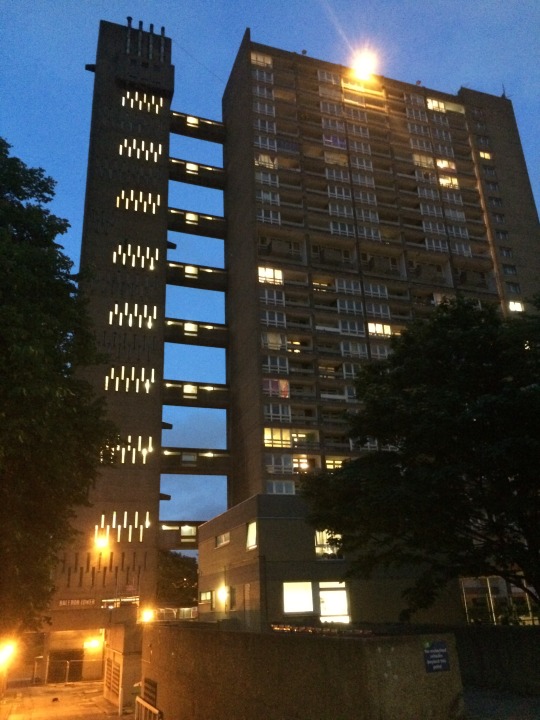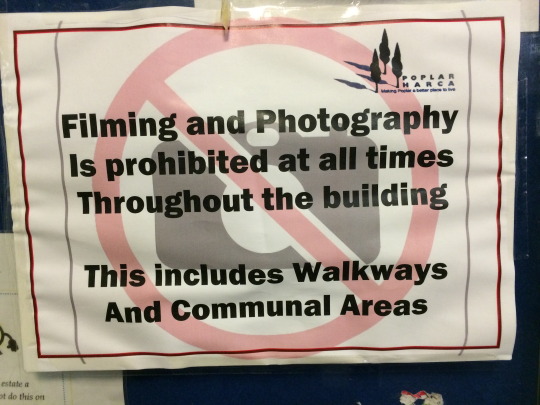
Balfron Tower, July 2015 pic: @balfronsocial
This guest blog post, by artist Rab Harling, is a transcript from his presentation to the “Social Injustice & Inequalities: ‘Race, Gender & Class’” conference at The Centre for Social Justice and Inequalities, Department of Sociology, University of Warwick on 10th July 2015.
Between February 2011 & February 2014, I was a resident of Ernö Goldfinger’s brutalist icon Balfron Tower in Tower Hamlets. Throughout this period, predominantly making connections through word-of-mouth, I set about capturing, on large format transparency film, from a singular viewpoint, a perspective from within each of my neighbour’s homes. By taking an identically situated photograph in as many of my neighbour’s homes as possible, I intended to deconstruct the form of the architecture of Balfron Tower, with my ultimate intention being to create an, as yet unrealised, photographic sculpture of the building in its geometrically deconstructed form: effectively turning Balfron Tower Inside out.
During this process I encountered a glimpse into the function of Balfron Tower and the realities of some of the lives occupying this Grade II listed, purpose-built social housing block; a block under attack from regeneration by those who claim to have the best interests of the community at heart. Balfron Tower is being regenerated. I believe that the proposed wholesale removal of social housing and its subsequent sale on the private market is not regeneration but social cleansing.
I will now play you a slideshow I made using approximately 40% of the material I captured, with a narration from Keith, who lived in Balfron Tower for 15 years between 1998-2013, before being relocated out of the borough, with no option to return to his home in the gentrified tower.
SCREENING of
Inversion/Reflection: Turning Balfron Tower Inside Out
(password: balfron)
Another five years of Conservative cultural policy finds us experiencing a culture-industry being shaped by powerful forces. In austere times public money for luxuries such as art must engage “the community”. The recent RSA and Warwick Commission report “Enriching Britain: Culture, Creativity and Growth” highlights “participation” as its key recurring feature.
But what happens when publicly funded arts organisational agenda conspire against grass-roots community creativity? Social restructuring is devastating London’s working-class communities, and artists are being co-opted and curated to participate in the PR.
Balfron Tower’s social housing tenants have now mostly been “decanted”. Commencing back in 2007 the buildings housing association owner started to split the community up, using a variety of nefarious and ethically redundant tactics. The community was then partly replaced mostly by young, short-term occupants and property guardians with insecure tenancies. A large number of the 146 flats were being rented to artists by a local “arts” organisation to serve as live / work spaces for artists.
This process is now commonly referred to as “artwash” and was being tactically and ruthlessly employed at Balfron Tower; a usually highly effective PR tool to be used as luxury flats replaced social housing; with artists paying £800 a month for the privilege of living and working in the tower.
Artists were, mostly unwittingly though some with enthusiastic complicity, being used to paper over cracks in the proposed privatisation of the tower. However, things did not exactly run to plan. Residents, already incensed by the loss of their homes and the appalling way they were being treated by the housing association, took exception to artists using their homes as the backdrop for their dystopian visions; constantly delayed by film crews occupying lifts and obstructing access and also very much aware that the ‘artwash’ was part of the gentrification process that was costing them their homes. This was not helped by the aggressive attitude towards them by the housing association and the arts organisation; an Arts Council England national portfolio organisation, an organisation that paradoxically sells itself as both a resource for emerging artists as well as an agency that uses artists to ‘regenerate’ neighbourhoods and force working class communities from their homes.

Welcome to Balfron Tower pic: @rabharling
By late-2010 when I proposed my project to the “arts” organisation, a ban on art projects taking place in or around the building was already being aggressively enforced by the residents committee. There was no mention of this as I laid down a significant security deposit (which was never returned) on top of the £800 for a months rent. I was later told that they believed that I would give up and move on, something I witnessed so many other artists do after trying half-heartedly to get disinterested and often hostile people to participate in their projects.
Throughout the three years I was in Balfron Tower, I encountered parameters of aggressive cultural curation that were waging a neoliberal war on the working classes. Revenge evictions and intimidation were commonplace against artists that didn’t fit with the corporate brand, or expressed even the slightest critique, either through their work or in the media, both mainstream and social. Top-down art-led social restructuring was being ruthlessly foisted upon neighbourhoods and being generously funded by Arts Council England.
Meanwhile, behind the spectacle, social housing was being asset-stripped.
I believe that the use of artists as a smokescreen for the social cleansing of social housing is turning communities against artists and damaging a profession that like so many others in recent years, has been subjected to a bland, mono-cultural middle-class curation that is strangling creativity. Art has been reduced to a carefully curated spectacle and those that want to play must conform.
How can communities respond to art, and artists, as they are so often encouraged to do so, when artists have come to symbolize the devastation of their communities? How can the recent plethora of publicly funded reports such as the RSA and Warwick Commission report be taken as anything more than well meaning committee minded groupthink, somewhat detached from the implications the realities these policies are creating on the ground.
The result has been that artists are sadly increasingly seen as harbingers of the wrecking ball, or in the case of Balfron Tower, thanks to its protected heritage status, harbingers of impending Canary Wharf bankers, with little or no interest in the social heritage of their luxury, highly fashionable apartments.
Balfron Social Club
Poplar
14 July 2015

